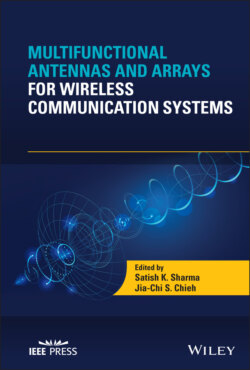Читать книгу Multifunctional Antennas and Arrays for Wireless Communication Systems - Группа авторов - Страница 20
1.7 Frequency Agile/Tunable Antenna
ОглавлениеA frequency agile or tunable antenna can be realized by integrating tunable RF components such as varactor diodes or RF micro‐electro‐mechanical‐systems (MEMS) variable capacitors in an antenna structure. Like a reconfigurable antenna, such antennas also require necessary bias networks such as those implemented in [2] and shown in Figure 1.4a–c and hence is not repeated again. The antenna impedance and radiation mechanism depends on the variation in effective permittivity which in turn is related to the change in capacitance variation. Frequency (f) of an antenna can be described as follows:
(1.1)
where L and C are the inductance and capacitance of an antenna.
To demonstrate mechanism of such an antenna, an example is now discussed from [5]. The antenna utilizes a meandered planar portion on the right‐hand side, which includes a varactor diode and its biasing network and a rectangular‐shaped cutout portion on the left‐hand side on the central feed arm (Figure 1.11). The varactor capacitance variation alters the electrical length of the meandered portion of the antenna, which in turn varies the resonance frequency of the antenna. In addition to the tunable meandered portion of the antenna, the design also includes a rectangular‐shaped cutout geometry for realizing higher band. Thus, this antenna follows a two‐step design approach.
In the first design step, the meandered line was chosen as the location for placement of the varactor diode. Since the meandered line enables the antenna to resonate at the lower frequency band, adding a varactor to this section allows the antenna to become tunable. To provide a wider tunable band between 690 and 970 MHz, the meandered line's electrical length is essentially increased by adding the varactor diode (SMV1281). After optimizing the antenna with the varactor diode set in place, Figure 1.12 shows the meandered line length as ML = 137.5 mm, which is slightly below λ/2 at 970 MHz and the width of the meandered line is MW = 1.2 mm.
Figure 1.11 Antenna geometry with varactor diode and biasing network.
Source: Damman et al. [5].
Figure 1.12 Design parameters for the low (right) and high bands (left).
Source: Damman et al. [5].
The second design step requires adding a higher band antenna structure to the design such that, while the tuning of the lower band is obtained, the higher band is consistently present. The higher band antenna was chosen as a simple rectangular‐shaped structure with a rectangular‐shaped slot which was cutout within the middle of the structure (Figure 1.12). Adding this cutout improved the matching of the higher band and subsequently lowered the effect of frequency tuning in the higher band when the lower band was tuned. In such an antenna, current distributions on the two portions of the antenna should be as independent as possible, which is shown in Figure 1.13a and b for the lower and upper bands, respectively, for capacitance value of 1.6 pF. When the lower band meandering structure is radiating, it has little effect on the upper band antenna. The outer rectangular length and width are RL = 25 mm and RW = 22.25 mm. The rectangular slot cutout (slot length of SL = 15 mm and a slot width of SW = 5.125 mm) dimensions are noted. The centerline feed has a length and width of FL = 19.5 mm and FW = 3 mm. Photograph of this antenna is shown in Figure 1.14 with an overall substrate size of length L1 = 80 mm and width W1 = 60 mm. The material used was FR‐4 (εr = 4.4) with a thickness of t = 0.762 mm. Response of this antenna can be found in [5] and hence is not repeated here.
As a reconfigurable antenna, the lower band meandered antenna also includes a biasing network. The DC biasing lines are placed on the same side as the ground plane (Figure 1.12), so as to limit the effect of coupling. The DC biasing lines include a RF choke inductor to block any high‐frequency signal from entering the DC power supply. A current limiting resistor is also added to the positive voltage terminal to protect the varactor diode. On the top side of the antenna where the radiating structure is located, a single DC blocking capacitor is placed above the varactor diode such that the potentially damaging DC supply voltage does not enter the RF signal. For the varactor diode, the reverse biasing voltage is varied from 0 to 20 V which varies the capacitance from 13.3 to 0.69 pF, respectively.
Figure 1.13 Surface current distribution with capacitance of 1.6 pF: (a) 810 MHz and (b) 1.68 GHz.
Source: Damman et al. [5].
Figure 1.14 Photograph of the fabricated single‐feed dual band antenna: (a) top view and (b) bottom view.
Source: Damman et al. [5].
Although mechanisms to achieve frequency reconfigurable and frequency agile/tunable antenna are different, for our discussion, we refer both antennas under the “Reconfigurable Antenna,” category.
